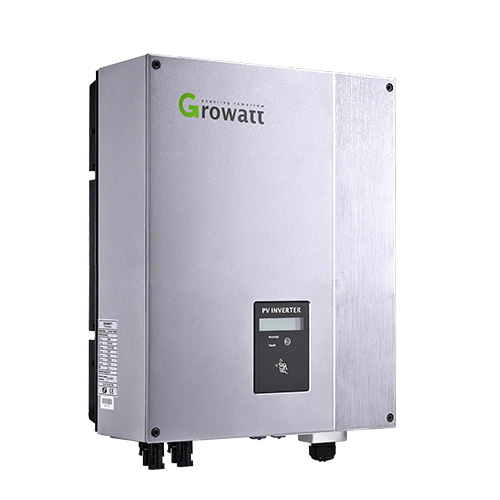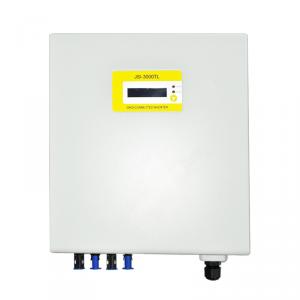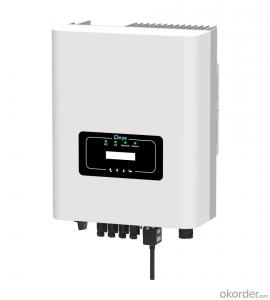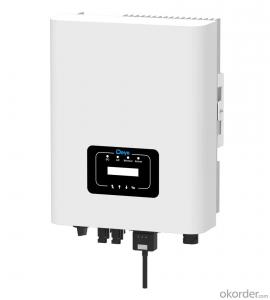Solar Inverter Price 2500MTL-3000MTL 2MPPT, Single Phase
- Loading Port:
- Shekou
- Payment Terms:
- TT or LC
- Min Order Qty:
- 10 pc
- Supply Capability:
- 100000 pc/month
OKorder Service Pledge
OKorder Financial Service
You Might Also Like
Solar inverter 2500MTL-3000MTL 2MPPT, single phase
Specifications
Maximum efficiency of 98% and wide input voltage range
Internal DC switch
Transformerless GT topology
Multi MPPT
Solar inverter General Descriptions
Leading-Edge Technology
> Maximum efficiency of 97.9 % and wide input voltage range
> Muti MPP controller
> Internal DC switch
> Transformerless H6 topology
> Compact design
> Muti MPP control
> MTL-String
> Bluetooth technology
> Easy installation
> Sound control
Europe /Australia ENS
> Simple national setting of line supply monitoring (ENS)
> Easy country configuration
> Muti-language display
> Currently available for Germany,France,UK,Austria,Switzerland,Italy and Spain
Solar inverter Communications
> RS485 /RS232/GPRS interfaces
> Computer monitoring software
Safety
> Full protection functions:DC reverse polarity, AC short-circuit protection, ground fault monitoring, grid monitoring, integrate all-pole sensitive, leakage current monitoring unit.
> Standards complied: SAA, CE/TUV, EN50178, VDE 0126-1-1,IEC 62109,RD 1663,G83,EN 61000-6-1,EN61000-6-2 ,EN61000-6-3,EN61000-6-4, DK5940, G83, RD1663, VDE-AR-N415, CEI 0-21
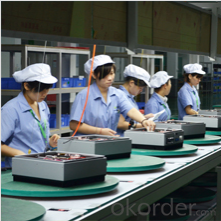
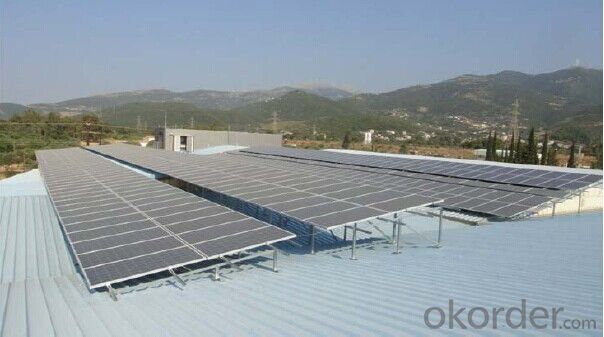
Technical Specifications
Model | 2500MTL | 3000MTL |
INPUT DATA | ||
Max. DC Voltage | 500V | 500V |
PV voltage range | 200V~500V | 200V~500V |
MPP Voltage Range | 200V~450V | 200V~450V |
Max. DC Power | 2700W | 3200W |
Max. Input Current | 10A/10A | 10A/10A |
Number of MPP Trackers/ | 2/1 | 2/1 |
Strings Per MPP Tracker | ||
OUTPUT DATA | ||
Nominal AC Output | 2500W | 3000W |
Max.Output Current | 12.5A | 15A |
Grid Voltage Range | 180~280V | 180~280V |
Rated Grid Frequency | 50Hz/60Hz | 50Hz/60Hz |
Output Current THD | < 3% | < 3% |
AC connection | Single phase | Single phase |
SYSTEM | ||
Max. Efficiency | 97.50% | 97.50% |
Euro. Efficiency | 97.00% | 97.40% |
MPPT efficiency | 99.50% | 99.50% |
Protection Degree | IP65(outdoor) | IP65(outdoor) |
Operating Temperature | -25~+60°C | -25~+60°C |
Cooling Method | No fan | No fan |
Display | LCD | LCD |
Standard Comm. Interfaces | RS485/RS232 | RS485/RS232 |
Optional Comm. Interfaces | GPRS/blue tooth | GPRS/blue tooth |
MECHANICAL DATA | ||
Dimensions(WxHxD) | 360/510/188mm | 360/510/188mm |
Net Weight | 15.6kg | 15.6kg |
Solar inverter FAQ
1. Have any design tool and how to use it?
Shine Design is the system design software just for inverters, It can conduct installers to figure out panel numbers for a system, panel numbers for each string, and which inverter model is suitable for the system. Moreover, it can print a design report after input all necessary parameters, can calculate DC/AC wire wastage, annual generation, etc.
2. Does the inverter have monitoring solutions for residential system?
For small rating system, we have wired two monitoring solution (ShineNet via RS232 or RS485). (a) Local wireless monitoring solution (ShineVision via RF module communication) (b) Global wireless monitoring solution (WIFI module via WIFI network)
3. Do you have free solution for monitoring?
ShineNet is an inverter monitoring software run in Windows XP, Windows Vista, Windows 7 operating system. It can monitor inverter via RS232 (or RS232 convert to USB cable) and RS485 wire connection. Customers can purchase the cable locally to get the inverter monitored, it is simple.
- Q: How does a solar inverter handle variations in battery charge levels?
- A solar inverter typically handles variations in battery charge levels by constantly monitoring the charge level of the battery. It adjusts the energy flow from the solar panels to the battery based on its charge level. When the battery charge is low, the inverter increases the energy flow from the solar panels to charge the battery. Conversely, when the battery charge is high, the inverter reduces the energy flow to prevent overcharging. This dynamic control ensures efficient use of the available solar energy and optimal charging of the battery.
- Q: Can a solar inverter be used with different grid voltages or frequencies?
- No, a solar inverter cannot be used with different grid voltages or frequencies. Solar inverters are designed to convert the DC power generated by solar panels into AC power that matches the specific grid voltage and frequency of the electrical grid it is connected to. Using a solar inverter with different grid voltages or frequencies can cause damage to the inverter and may result in a loss of efficiency or functionality.
- Q: Can a solar inverter be easily integrated into an existing electrical system?
- Yes, a solar inverter can be easily integrated into an existing electrical system. Solar inverters are designed to seamlessly connect with the existing electrical infrastructure of a building or property. They can be installed alongside the main electrical panel and connected to the grid, allowing the solar energy generated by the panels to be converted into usable electricity for the building's consumption. With the help of a qualified electrician or solar installer, the integration process can be straightforward and efficient.
- Q: Can a solar inverter be used with solar-powered security systems?
- Yes, a solar inverter can be used with solar-powered security systems. A solar inverter is responsible for converting the DC power generated by solar panels into AC power that can be used to power various electrical devices, including security systems. By using a solar inverter, solar-powered security systems can efficiently utilize the energy generated by solar panels to operate effectively.
- Q: What is the difference between a centralized and decentralized solar inverter system?
- A centralized solar inverter system involves connecting multiple solar panels to a single inverter, with all the panels connected in series. The combined DC power generated by the panels is then converted into AC power by the centralized inverter. On the other hand, a decentralized solar inverter system, also known as microinverters or power optimizers, consists of each solar panel having its own dedicated inverter. In this system, each panel operates independently and converts its DC power into AC power directly at the panel level. The main distinction between the two systems lies in their architecture and power conversion methods. In a centralized system, the overall power output of the entire array depends on the performance of a single inverter. If any panel in the array underperforms due to shading or malfunction, it can significantly impact the overall system's performance. Additionally, a single inverter can limit design flexibility and system scalability. In a decentralized system, each panel operates independently, allowing for greater flexibility and optimization. The individual inverters in a decentralized system can maximize the power output of each panel, regardless of shading or performance variations. This also means that the overall system performance is less affected by the underperformance of a single panel. Moreover, decentralized systems offer better scalability as additional panels can be easily added without the need for significant system redesign. Decentralized systems also provide improved monitoring capabilities, as each inverter can provide real-time data on individual panel performance. This simplifies troubleshooting, maintenance, and issue identification within the solar array. To summarize, while a centralized solar inverter system is a simpler and more cost-effective option, a decentralized system offers better optimization, scalability, monitoring, and performance reliability. Choosing between the two systems depends on factors such as system size, shading conditions, budget, and desired level of control and flexibility.
- Q: Do I need a special inverter for a battery storage system?
- Yes, a special inverter is required for a battery storage system. Unlike traditional solar inverters that convert DC power from solar panels into AC power for immediate use or for feeding back into the grid, a battery storage system inverter is designed to manage the charging and discharging of the batteries. It ensures that the stored energy is used efficiently and safely, and allows for backup power during grid outages.
- Q: How does a solar inverter handle low light conditions or cloudy days?
- A solar inverter handles low light conditions or cloudy days by continuously monitoring the incoming solar energy. When there is a decrease in sunlight, the inverter adjusts its voltage and current output to optimize the power conversion. This ensures that even under low light conditions, the inverter can still convert the available solar energy into usable electricity efficiently.
- Q: Can a solar inverter be repaired or does it need to be replaced?
- A solar inverter can often be repaired instead of being replaced, depending on the extent of the damage.
- Q: Can a solar inverter be used with solar-powered electric fences?
- Yes, a solar inverter can be used with solar-powered electric fences. A solar inverter is responsible for converting the direct current (DC) generated by solar panels into alternating current (AC) that can be used to power various devices, including electric fences. This allows for an efficient and sustainable solution to power electric fences using solar energy.
- Q: Can a solar inverter be used with a solar-powered refrigerator?
- Yes, a solar inverter can be used with a solar-powered refrigerator. A solar inverter is responsible for converting the direct current (DC) produced by solar panels into alternating current (AC) that can be used to power appliances, including refrigerators. Therefore, a solar inverter is an essential component in connecting a solar-powered refrigerator to a solar panel system.
Send your message to us
Solar Inverter Price 2500MTL-3000MTL 2MPPT, Single Phase
- Loading Port:
- Shekou
- Payment Terms:
- TT or LC
- Min Order Qty:
- 10 pc
- Supply Capability:
- 100000 pc/month
OKorder Service Pledge
OKorder Financial Service
Similar products
Hot products
Hot Searches
Related keywords






